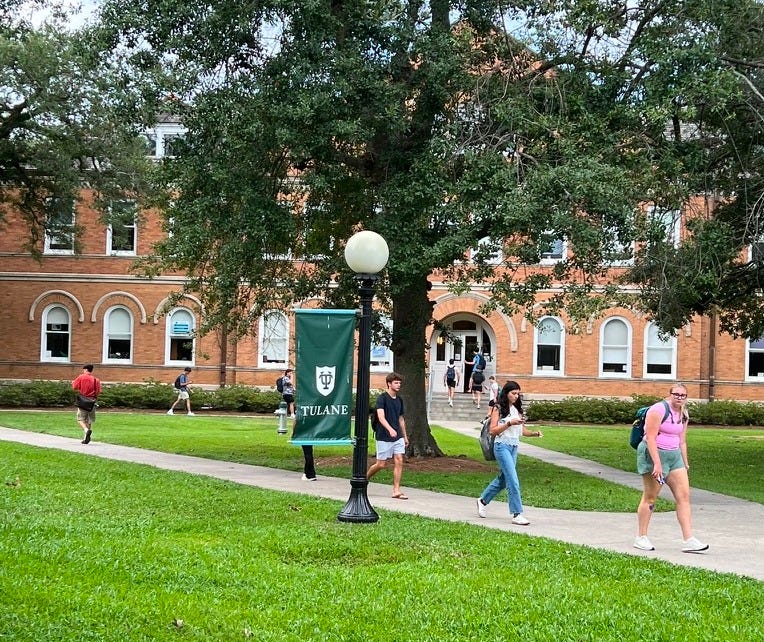Applying Early is Important (yes, this topic again)
Submitting by Oct 31 boosts admission odds, scholarships, and access to impacted majors across ED, EA, RD, and rolling.
“The University of Michigan has announced it will offer an Early Decision (ED) option to high school students applying to the school in the coming application cycle, a move that secures enrollments for the university at an earlier stage.”
This is an acceleration of a trend.
Michigan is of course the flagship state university in Michigan. But, did you know that 45% of their incoming freshman class is actually made up of non-Michigan residents? And this doesn’t even include international students.
In other words, the state school of Michigan is largely made up of students from elsewhere.

Michigan, like many other states, isn’t (or can’t) fully fund its state institutions, and so those schools use full-pay out-of-state and international students to make up for budget shortfalls. Yes, I’m picking on them a bit. But their out-of-state cost of attendance is $84K/year for lower school students and goes up to $88K/year for juniors and seniors!
Adding an ED option ensures Michigan is able to “lock-in”, early in the class of 2026 enrollment process, these full-pay out-of-state and international students. And as more of their incoming class fills up via early decision applicants, there will be less available to those students who choose to apply later and weigh their options.
Most colleges - not just Michigan - will continue to strongly prefer candidates who apply early, through any of the available application plans (ED, EA, RD, rolling, etc…).
I’ve talked about the importance of getting apps into colleges as early as possible senior year (here and here).
But this deserves repeating…
The single most important way to maximise your chances, and choices, in college admissions is to apply early.
“Early” means having your applications submitted by Oct-31.
And it doesn’t just mean Early Decision. It means regardless of admission plan, turn in your app.
Let me break this down into three simple parts:
Why colleges reward early applicants
What fills early (and why you’ll want to submit by Oct-31)
A small list of exceptions
Why Colleges Reward Early Applicants
Capacity & shaping: Earlier files are read when the incoming class, majors, scholarships, and special programs are most open.
Budget timing: Merit money and program spots are allocated throughout the cycle, and more is available earlier. Also, colleges are businesses - and securing paying customers early (enrolled students) means greater budget certainty for the institution.
Operational reality: Complete, early files reduce uncertainty; colleges love them and often move them faster.
And by admission plan -
Early Decision, aka ED (binding): Historically higher admit rates; earliest read; strongest interest signal.
Early Action, aka EA (non-binding): Often priority for merit/honors/programs and also typically comes with an admissions boost while keeping options open. Seen by colleges as “demonstrating interest”.
Regular Decisions, aka RD submitted early: You’re in the front half of the queue while more seats and dollars remain. Plus, many colleges give you an answer within a few weeks of submitting your app. Getting back “yes” answers early in your senior year can feel great!
Rolling: Truly first-come, first-served. Programs and scholarships can fill by late fall.
More on the trend towards preferencing early applicants…
In 2018-2019, Middlebury College admitted 26% of all its incoming freshmen via early admission plans. In 2024, it was 68%.
In 2018-2019, Claremont McKenna College admitted 33% of all its incoming freshmen via early admission plans. In 2024, it was 67%.
In 2018-2019, Boston University admitted 9% of all its incoming freshmen via early admission plans. In 2024, it was 59%.
What fills early (and why you’ll want to be in line by Oct-31)
Direct-admit / impacted majors (CS, nursing, business, engineering).
Honors colleges, living-learning communities, scholars programs.
Priority scholarship deadlines (often Nov 1/Nov 15/Dec 1).
Housing selection order (at some schools).
Large publics with early “regular” deadlines. Some examples: University of Washington, University of California system, etc… These can be surprisingly early. University of Washington in my home state, for example, has a regular decision deadline of Nov-15.
The older, assumed deadline of applying to colleges by Jan-1 just isn’t how many colleges operate today.
Exceptions, e.g. “I’m waiting on SAT/ACT or fall grades—now what?”
Don’t let one pending data point impact your whole college list.
Split your colleges into two buckets: (1) schools that you can apply to right now that are test-optional, accept scores after submission, or don’t need first-semester grades (or where a change in grades is likely to have little impact); (2) schools that truly require the new info for a realistic bump.
Submit every app in bucket 1 by Oct-31.
And be realistic with bucket 2. Is getting a small GPA boost or a higher SAT score really going to significantly increase your chances?
Here’s how to segment your list:
Apply early to schools that are test-optional, accept scores later, or don’t need fall grades to decide.
Hold back only the few that truly require new scores/grades for a realistic bump.
Submit, then update:
Most colleges allow scores to arrive after the app; counselor documents often follow.
Use portals to upload new scores and let colleges know when to expect them.
Maximize EA/Rolling: Lock in early reads of your apps where available while you gather new data for a small remainder list.
If testing again: Keep your app moving. Don’t delay essays, activities, and recs; only the score report waits.

